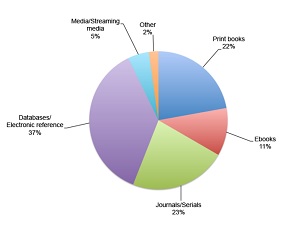LJ Study: Electronic Resources Continue Steady Gains in Academic Libraries
 More than one-third (37%) of academic library materials budgets go to database subscriptions and electronic reference materials, followed by journals and serials (23%), print books (22%), ebooks (11%), and media/streaming media (5%), according to the Academic Library Collection Development Survey 2017, conducted by LJ’s research department and sponsored by EBSCO.
More than one-third (37%) of academic library materials budgets go to database subscriptions and electronic reference materials, followed by journals and serials (23%), print books (22%), ebooks (11%), and media/streaming media (5%), according to the Academic Library Collection Development Survey 2017, conducted by LJ’s research department and sponsored by EBSCO.
Book holdings are still weighted toward print, with survey respondents, on average, describing print as 60.3 percent of their overall collection, and ebooks as 39.7 percent. However, respondents expect budgets to continue shifting away from print. They estimated that five years from now, print books will account for only 16 percent of their budgets, with ebooks rising to 15 percent.
This trend is already evident at academic libraries with materials budgets larger than $1 million, which report having a 55.6%/44.4% print/ebook mix, compared to the 65%/35% mix reported by libraries with budgets under $100,000. Format preference varied significantly by academic discipline. Notably, 79 percent of respondents said print was preferred over ebooks for arts and humanities subjects, compared with 29 percent who said the same for education content, or nursing (19%), business (19%), mathematics (18%), sciences (16%), law (11%), technology (9%), medicine (9%), or engineering (6%).
By comparison, 47 percent said that ebooks are now preferred over print for books about technology, science (44%), business (34%), nursing (32%), engineering (24%), medicine (23%), mathematics (14%), and education (12%). In the survey of 282 academic librarians who are directly involved with their libraries’ recommendation or purchasing process, 37 percent of respondents said review sites were the top source that they used to discover content, followed by articles/journals (29%), publisher websites (10%), reading lists/software (5%), and word of mouth (3%). Sixteen percent chose “other” with write-in responses including faculty requests and direct contact from vendors or publishers.
More than half of respondents (57%) said that usage statistics were the most critical data points that help inform their collection development choices, followed by circulation (18%), curriculum or assignment support (16%), faculty or user requests (12%), cost per use (10%), price (9%), turnaway data (5%), student enrollment in specific programs (4%), subject collection development policies (4%), interlibrary loan stats (4%), reviews (2%), and full-text downloads (2%).
In write-ins, several respondents expressed the need for better and more comprehensive data analytics. One wrote that more was needed for recently acquired materials, which “could take some of the guesswork out of my purchasing decisions” by quickly clarifying whether students are really using these materials. Another noted that “I need more analysis support within the library. Vendors will provide analysis with a spin, so it’s not good enough.”
Respondents said that the decision to purchase materials in print or electronic formats is driven by faculty preference (63%), availability of content by format (60%), student preference (59%), and pricing (56%). When asked to rate their single biggest challenge for collection development—with “funding” eliminated as an option—14 percent of respondents said getting input from faculty, and 11 percent said format decisions (print vs. electronic, etc.), followed by time constraints (10%), limited shelf space (7%), selecting items that will be used (7%), licensing complexities for electronic materials (6%), sourcing materials (6%), anticipating the needs of individual courses (4%), and keeping up with rapid change (4%).
Only seven percent of respondents said that their library purchases e-textbooks, and only 17 percent said their library does not currently order them, but that eTextbooks were under consideration. Libraries with budgets of $1 million or more were the most likely to offer these resources. More than three quarters (76%) said that they do not currently order eTextbooks and were not considering adding them. For more information, download the full 58-page report here.
RELATED
ALREADY A SUBSCRIBER? LOG IN
We are currently offering this content for free. Sign up now to activate your personal profile, where you can save articles for future viewing









Add Comment :-
Comment Policy:
Comment should not be empty !!!